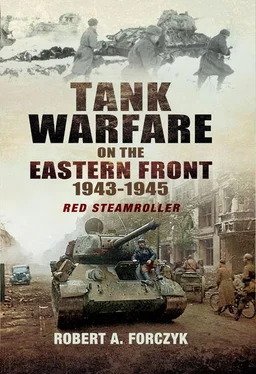In the north, the PzAOK 4 finally evacuated its Kiev bridgehead by 30 September and repulsed several efforts by Vatutin’s forces to cross the Dnepr north of Kiev. On 5 October, the 38th Army managed to seize a small bridgehead at Lyutezh, 25km north of Kiev, which was reinforced with three rifle divisions in a week. For his part, von Manstein regarded the swampy terrain north of Kiev as unsuitable for armour and did not attach much importance to the Lyutezh bridgehead. Instead, he ordered the XIII Armeekorps to seal off the bridgehead with two infantry divisions and directed Hoth to position the 7. and 8.Panzer-Divisionen nearby as mobile reserves, just in case. By the beginning of October, von Manstein was focused on crushing the Bukrin bridgehead and containing Konev’s lodgement south of Kremenchug. The Stavka was equally intent upon transforming these tactical successes into the springboard for a major operational victory and ordered Konev and Vatutin to attack as soon as they had sufficient forces across the Dnepr.
Vatutin moved an artillery division to support the Bukrin bridgehead and on 24 October he began a major effort to break through the XXXXVIII Panzerkorps’ perimeter. The Soviets were able to gain a little ground, assisted by river crossings on both flanks, but the Germans moved up the Das Reich and the 11.Panzer-Division to reinforce the defence. In very heavy fighting, the Soviet offensive was stopped cold and the Germans claimed 140 enemy tanks knocked out. By late October, Vatutin realized that the German defences were too strong at Bukrin and he ordered his forces in the bridgehead to shift to the defence. On 20 October, the Stavka also decided to redesignate the Soviet fronts: Vatutin’s Voronezh Front became the 1st Ukrainian Front, Konev’s Steppe Front became the 2nd Ukrainian Front, Malinovsky’s Southwestern Front became the 3rd Ukrainian Front and Tolbukhin’s Southern Front became the 4th Ukrainian Front.
While Vatutin’s front was stymied, Konev enjoyed the greatest success from his bridgeheads located between Kremenchug and Dnepropetrovsk. When looking at the German Lage Ost (Situation East) maps for 1 October 1943, it appears that von Manstein had succeeded in creating a continuous line behind the Dnepr and that the few small Soviet bridgeheads were highly vulnerable to the converging German Panzer-Divisionen. However, in order to create this continuous front, von Manstein had to spread his depleted armoured units out across an 800km-wide front – his only reserves were whatever unit was inbound on the next train from France or Germany. In the Uspenka-Deriyivka sector (which was soon known as the Myshuryn Rog bridgehead), the PzAOK 1’s LII Armeekorps had the 23. Panzer-Division and Großdeutschland backing up two infantry divisions. While the presence of these units probably appeared sufficient to Hitler in Rastenburg, Großdeutschland only had 15 operational tanks (including five Tigers) and 23.Panzer-Division had seven tanks, nine SPWs and 1,100 infantry left. {186} Even worse, so many trucks had been lost in the retreat that panzer units were forced to borrow horses and wagons from nearby infantry units to conduct their resupply operations. Combat damage, worn-out equipment and mechanical defects had reduced almost all of von Manstein’s armoured units to minimal combat effectiveness. Further diluting their combat power, the remaining panzers were spread out to reinforce the weakened infantry, meaning that in order to employ anything larger than a tank platoon in any sector, the Germans were forced to strip other sectors of armoured support. The Soviets were quick to notice this new German weakness and began attacking sectors that had been denuded of armour. On 2 October, Konev’s infantry expanded their bridgehead and captured Myshuryn Rog; it took two days for 23.Panzer-Division to organize a counter-attack, which amounted only to a company of pioniers, some tanks and SPWs. By this time, Konev had a bridge built over the Dnepr near Borodaivka, on the eastern side of the Myshuryn Rog bridgehead, and was pushing tanks across. Furthermore, on 3 October, Konev received Rotmistrov’s 5 GTA, which had spent three weeks refitting in the rear. Rotmistrov stealthily moved his tank army 200km forward to the Dnepr in night marches, to avoid Luftwaffe reconnaissance.
Through great effort by the Instandsetzungsgrupe , the 23.Panzer-Division was able to repair 15 tanks by 7 October, including some of Fechner’s Panthers. {187} General der Panzertruppe Friedrich Kirchner, commander of LVII Panzerkorps, decided to commit both the 23.Panzer-Division and Großdeutschland to a joint counter-attack at Annovka and Borodaivka, in order to threaten the Soviet bridge site. On 8 October, Fechner’s Panthers attacked Soviet infantry at Annovka and managed to knock out three T-34s and 11 anti-tank guns, without loss. However, Großdeutschland ’s attack on 9 October was poorly organized and five Tigers advanced toward Borodaivka without close infantry support. On this occasion, the Tiger’s powerful main gun and thick armour did not save them; all five tanks were surrounded and picked off at close range by concealed anti-tank guns and infantry tank destroyer teams. At least two crews were captured, the rest killed – a net loss of 25 Tiger crewmen. {188} Following this disaster, the German counter-attacks diminished somewhat, which allowed Konev a breathing space to begin moving the lead elements of Rotmistrov’s 5 GTA into the Myshuryn Rog bridgehead on the night of 14–15 October.
On the morning of 15 October, the Soviet 37th Army and 7th Guards Army attacked the thinly-held German perimeter south of Myshuryn Rog with four guards airborne divisions and three rifle divisions, following a massive artillery preparation. Rotmistrov was only able to contribute the 7 MC and part of 18 TC on the afternoon of the first day of the offensive. {189} Vormann’s 23.Panzer-Division was holding this sector with the depleted Panzergrenadier-Regiment 128 and divisional pioniers, but they were quickly overrun by this avalanche of men and tanks. Vormann committed his eight remaining tanks, but lost three Pz IVs when they encountered JSU-152 self-propelled guns and a wall of anti-tank guns. The remaining five German tanks retreated and Vormann’s other Panzergrenadier-Regiment was nearly surrounded by Soviet armour, so the entire 23.Panzer-Division fell back. Although seven of Rotmistrov’s T-34s were knocked out in the opening skirmishes, the German tankers noted that Soviet tanks had learned to use dead space to manoeuvre in order to reduce their vulnerability to anti-tank fire. {190} The Red Army was learning.
On 16 October, Rotmistrov brought the rest of 18 TC and 29 TC across the Dnepr and pressed the attack, quickly forcing the 23.Panzer-Division back, which created a 10km-wide gap in the German front. A Soviet tank brigade pressed into the gap, overrunning the 23.Panzer-Division’s Flak-Bataillon, then pushing on to attack Großdeutschland ’s divisional command post. Although Vormann managed to gather up three Panthers and three Pz IVs to conduct a mobile screen in the gap, they offered little serious resistance to Rotmistrov’s mass of armour. By the third day of the offensive, Rotmistrov’s armour had achieved a clear breakthrough and surged forward to overrun Vormann’s command post and support units in Popel’naste. Although the Germans claimed to have knocked out many of Rotmistrov’s tanks, the fact is that Soviet tanks were roaming in the rear areas, shooting up German support units. Both 23.Panzer-Division and Großdeutschland were forced to abandon many damaged tanks at workshops, leaving them with a combined total of about 12–15 operational tanks. Rotmistrov kept the pressure on, continuing to advance at night, in order to prevent the Germans from forming a new line. Soon, Kirchner’s LVII Panzerkorps headquarters was threatened by Soviet tanks and had to flee, causing a disruption in German C 2at a critical moment. Panic set in, as German support units fled rearward without orders – not unlike French troops in May 1940. It just got worse and worse for PzAOK 1, as Rotmistrov’s armoured fist exploited rapidly to the south. In life, there are few experiences as exhilarating as an armoured pursuit of a broken enemy and this must have been a heady moment for Rotmistrov’s tankers, as well as sweet revenge for Prokhorovka.
Читать дальше








![John Stieber - Against the Odds - Survival on the Russian Front 1944-1945 [2nd Edition]](/books/405234/john-stieber-against-the-odds-survival-on-the-russian-front-1944-1945-2nd-edition-thumb.webp)



